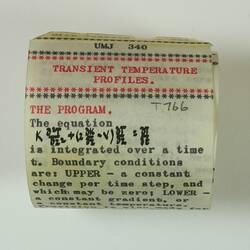Program for determining Steady State Temperature Profiles in Ice
The program used computed the temperatures in a vertical column of ice, specifically in the interior regions of Greenland and Antarctica, as well as through the ice shelves bordering the latter. It used the Heat Conduction Equation.
The basic assumption was that the ice had had sufficient time to reach a 'steady state' in which the temperatures had settled down and were without change. This implied that the ice was relatively stagnant.
The surface temperature was held constant as was the geothermal heat input to the base of the ice (heat from the interior of the Earth), or, in the case of floating ice, the base temperature was fixed at melting. The surface temperature gradient into the ice was an indicator of long-term climatic change. One interesting result was evidence that the base of the ice beneath Vostok station in Antarctica was melting, and thus the presence of a 'lake' seemed likely.
If the ice is not stagnant but flowing, then recourse to the following program is necessary.
Program for Transient Temperature Distributions
The program derives the changes with time of the temperatures in a column of ice, with specific application to Greenland and Antarctica.
When the ice flows downslope with any appreciable speed the assumption that the temperatures do not change is invalid, and thus the results of the program Steady State Temperature Distributions are in error. The main parameters determining the temperatures are the speed of the motion, the rate at which ice accumulates at the surface, and any climatic temperature change. The heat into the ice from the Earth below (the geothermal heat flux) is increased by the friction at the base of the ice. The temperatures and the temperature gradient determined at the surface of the column indicate likely climatic change. Melting at the base of the ice shows areas where 'lakes' exist at the ice/bedrock interface.
Melting at Vostok station, suggested by the steady state program is confirmed, the extent of the melt, and the rate of melt can be found. Varying the input surface temperature change, then comparing the surface temperature gradient with the observed, determines likely long-term climate variations much more validly than those determined by the steady state program.
More Information
-
Keywords
-
Authors
-
Article types

